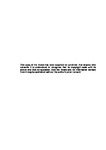The biological and ecological impacts of hypoxia on coastal benthic communities
| dc.contributor.supervisor | Spicer, John | |
| dc.contributor.author | Calder-Potts, Ruth Naomi | |
| dc.contributor.other | School of Biological and Marine Sciences | en_US |
| dc.date.accessioned | 2017-05-25T14:29:00Z | |
| dc.date.issued | 2017 | |
| dc.date.issued | 2017 | |
| dc.identifier | 214025 | en_US |
| dc.identifier.uri | http://hdl.handle.net/10026.1/9352 | |
| dc.description.abstract |
Traditionally, hypoxia has been defined as the situation where DO levels have fallen below 2.0 mg O2 L-1, but increasing evidence suggests that this low level of DO is inadequate to describe the onset of hypoxia impacts for many organisms. Consequently, there is a need for a greater understanding of how ‘moderate’ alterations in DO levels will affect ecosystem processes and functionality, specifically through behavioural and physiological alterations at the organism and community level. This thesis reports on mesocosm experiments which were conducted to examine the effects of moderate (> 3.0 mg O2 L-1) hypoxia on firstly, a key ecosystem engineer, the brittlestar Amphiura filiformis, and secondly, on the Station L4 infaunal macrobenthic community. Station L4 is a longstanding marine biodiversity and MSFD reference site and forms part of the Western Channel Observatory. At the organism level, short-term (14 d) exposure to moderate hypoxia significantly reduced oxygen uptake rates, oocyte diameter and oocyte development in A. filiformis. However, these physiological affects occurred irrespective of brittlestar population density. Additionally, moderate hypoxia reduced brittlestar activity, in terms of bioturbation behaviour, consequentially having an effect on ammonium and silicate fluxes. These observations were only detected when brittlestar population density was high. It was concluded that denser populations of A. filiformis may therefore exhibit the greatest changes in behaviour and shifts in ecosystem function as competition for resources and oxygen heightens. The benthic community at Station L4, displayed considerable tolerance to medium-term (6 wk.) exposure to moderate hypoxia, in terms of structure, diversity and bioturbatory behaviour, but these results may be different if exposure was longer or more severe. Alterations in nutrient fluxes were detected, but there was little evidence to suggest these changes were due to macrofaunal behavioural alterations. Additionally, results from this study revealed that bringing complex natural communities into the mesocosm caused a substantial loss of individuals and species, mainly due to translocation and disturbance effects. This important insight into the effects of bringing community assemblages into the mesocosm confirms that even with a loss of diversity, the L4 community maintained functionality and was resilient to alterations in DO. This suggests that the L4 benthic community does not depend on any one specific species for the provision of important ecosystem processes, resulting in considerable functional resilience within the L4 system. However, vulnerability to benthic systems may increase if functionality is dominated by species such as A. filiformis. Consequently, moderate hypoxia may not immediately affect benthic communities in terms of structure and diversity, but the physiological effects on individuals, especially to reproductive development, may cause alterations in the quality and quantity of planktonic propagules supplied by benthic species to the pelagic environment. This could affect benthic community diversity and functionality in the long term if repeated hypoxic events occur. | en_US |
| dc.description.sponsorship | Natural Environment Research Council | en_US |
| dc.description.sponsorship | Plymouth Marine Laboratory | en_US |
| dc.language.iso | en | |
| dc.publisher | University of Plymouth | |
| dc.rights | Attribution-NonCommercial-NoDerivs 3.0 United States | * |
| dc.rights.uri | http://creativecommons.org/licenses/by-nc-nd/3.0/us/ | * |
| dc.subject | Hypoxia | en_US |
| dc.subject | Low Oxygen | en_US |
| dc.subject | Bioturbation | en_US |
| dc.subject | Invertebrate Ecology | en_US |
| dc.subject | Community Response | en_US |
| dc.subject | Global Change | en_US |
| dc.subject | Invertebrate Biology | en_US |
| dc.subject | Aerobic Respiration | en_US |
| dc.subject | Ecosystem Processes | en_US |
| dc.subject.classification | PhD | en_US |
| dc.title | The biological and ecological impacts of hypoxia on coastal benthic communities | en_US |
| dc.type | Thesis | |
| plymouth.version | publishable | en_US |
| dc.identifier.doi | http://dx.doi.org/10.24382/597 | |
| dc.rights.embargodate | 2018-05-25T14:29:00Z | |
| dc.rights.embargoperiod | 12 months | en_US |
| dc.type.qualification | Doctorate | en_US |
| rioxxterms.version | NA |
Files in this item
This item appears in the following Collection(s)
-
01 Research Theses Main Collection
Research Theses Main



